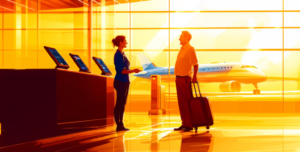Passenger expectations are soaring. Modern travelers demand seamless, personalized experiences from check-in to take-off. This shift, driven by tech advancements and the need for convenience, presents a dual challenge for airlines and airports – adapting to evolving demands while maintaining human connection.
Passengers want more
Today’s passengers are informed and discerning. They crave efficiency but also seek tailored experiences that cater to their unique needs. It’s not just about getting from A to B – they want a journey enriched with moments of care and understanding. The rise of low-cost carriers, premium travel classes and airport hospitality innovations reflects this growing demand for personalized and differentiated experiences.
Delivering on these expectations isn’t just about technology. Passengers want intuitive systems, yes, but they also need human touchpoints that demonstrate empathy, provide reassurance and resolve issues on the spot. Meeting this dual expectation requires a strategic approach that integrates advanced tools with empowered employees.
Employees – the game-changers of CX
The role of aviation employees has transformed dramatically. No longer mere operators of routine tasks, they’re now central to creating the human connections that technology can’t replicate. Employees act as the face of your brand, offering the personal touch that sets one travel experience apart from another.
This is where customer experience through employee experience (CXbyEX) comes into play. Research consistently highlights that engaged employees deliver better customer outcomes. According to a PwC study, 75% of consumers prioritize authentic human interactions, especially in industries like aviation where stress and uncertainty often accompany travel. Engaged employees not only improve customer satisfaction but also build brand loyalty and contribute to higher margins.
The human element matters more than ever
Self-service kiosks, biometrics and automation have revolutionized airports. They streamline operations, reduce wait times and improve efficiency. However, no matter how advanced the tech, it can’t replace empathy, reassurance, or a warm smile. Passengers value the human element – someone who listens, understands and resolves their concerns.
In the aviation sector, employees are more than service providers. They’re problem solvers, brand ambassadors and emotional anchors for passengers. Whether it’s assisting a first-time flyer, calming a stressed traveler, or adding a personal touch to a premium experience, employees make the difference between a good journey and a memorable one.
Balancing technology and human touch
Airports and airlines must deliver both efficiency and empathy. Digital tools streamline operations, but the emotional needs of travelers demand a human touch. Striking this balance is key to creating a standout passenger experience. For example, biometrics might expedite boarding, but it’s the gate agent’s friendly demeanor that leaves a lasting impression. Successful CX strategies find ways to harmonize these elements to create seamless and satisfying journeys.
How to create a brand-driven CX and EX strategy
A distinctive, consistent and memorable customer experience starts with a unified approach. Here’s a straightforward plan to align your brand with both customer and employee journeys:
Step 1: Define your brand narrative
Start with your brand’s positioning and create a clear narrative. This narrative should answer fundamental questions: Who are you? What’s your goal? What do you fight for (or against)? What makes you unique?
Identifying a common ‘enemy’ – like a passenger’s fear of the unexpected – can unite teams and guide consistent, brand-driven service excellence. For instance, a narrative centered on eliminating the unknown can empower employees to anticipate passenger concerns, offering proactive solutions that reinforce trust and reliability. A strong narrative serves as the guiding thread for everyone in the organization, aligning efforts across departments.
Step 2: Translate values into behaviors
Turn your brand beliefs into actionable employee behaviors. What do you want your teams to embody? Keep it simple – less is more. Complexity hinders adoption. For example, if your brand values empathy and efficiency, employees should be trained to combine problem-solving with warmth. Align these behaviors with your CX strategy to create a seamless CXbyEX approach.
Communication is crucial: leaders must act as ambassadors, ensuring clarity and consistency. Tools like role-playing workshops or behavior-focused coaching sessions can help employees internalize these values and bring them to life in their daily interactions.
Step 3: Bring it to life
Don’t just tell – show. Use emotional storytelling, workshops and creative campaigns to inspire employees. 95% of human behavior is driven by emotion. Engage hearts and minds to create enthusiasm for change. Empower employees with the tools to take action and sustain momentum.
For example, an airline might launch an internal campaign showcasing real stories of employees going the extra mile for passengers. Highlighting these moments creates pride and motivates others to emulate similar behaviors.
Step 4: Optimize key journey points
With the brand narrative and behaviors in place, focus on critical touchpoints like gate experiences or airport entrances. Address specific team challenges – from below-wing staff to premium customer service agents. Identify pain points in the passenger journey and address them through employee-driven solutions.
For example, improving the gate experience might involve training staff to handle delays with greater empathy and clear communication. For below-wing teams, recognizing their contributions through initiatives like personalized feedback or milestone celebrations can boost morale and efficiency.
Step 5: Share success stories
Align marketing with CX to highlight real success stories. Celebrate wins with your employees and customers. Positive feedback creates a flywheel effect – happy employees lead to happy customers, and vice versa. Showcase proof of your brand promise in action. For instance, sharing testimonials or moments of exceptional service through social media reinforces the message both internally and externally.

Employees – the heart of aviation CX
Engaged employees are the key to turning good passenger experiences into exceptional ones. Recognize their contributions and make them part of your bigger vision. By focusing on CXbyEX, you’ll create a motivated workforce and loyal customer base.
Engagement isn’t a one-time initiative – it’s an ongoing effort. Regular check-ins, recognition programs and opportunities for growth ensure employees feel valued and connected to the brand’s mission. When employees see themselves as integral to the passenger experience, their enthusiasm translates directly into better service.
Conclusion: Prioritize CXbyEX for aviation success
The aviation industry faces rising expectations and fierce competition. By investing in employee engagement and aligning it with customer experience, you can deliver exceptional service, foster loyalty and drive long-term success.
The future of aviation lies in the synergy between technological innovation and the irreplaceable value of human connection. Let your employees lead the way – they have the power to turn ordinary journeys into extraordinary ones, securing your place as a trusted and beloved brand in the eyes of your passengers.
For more top insights into the future of passenger experience, read Passenger Terminal World’s exclusive feature, “How can airports inspire positive passenger emotions to increase non-aeronautical spend?”, here.


